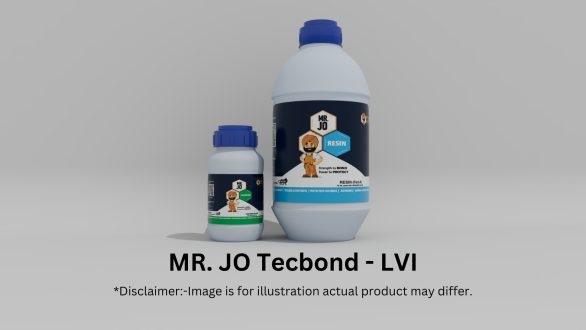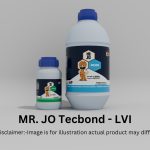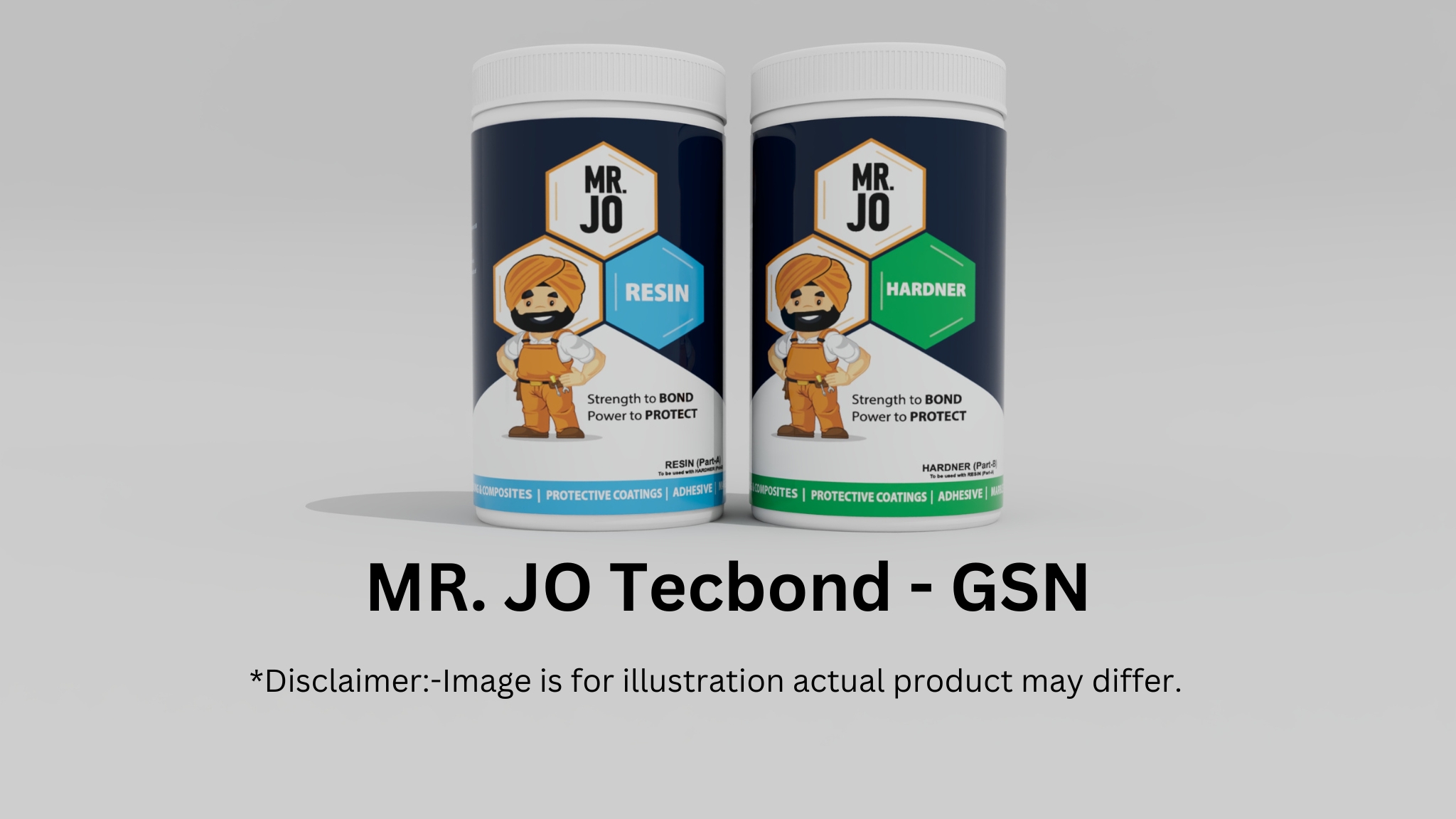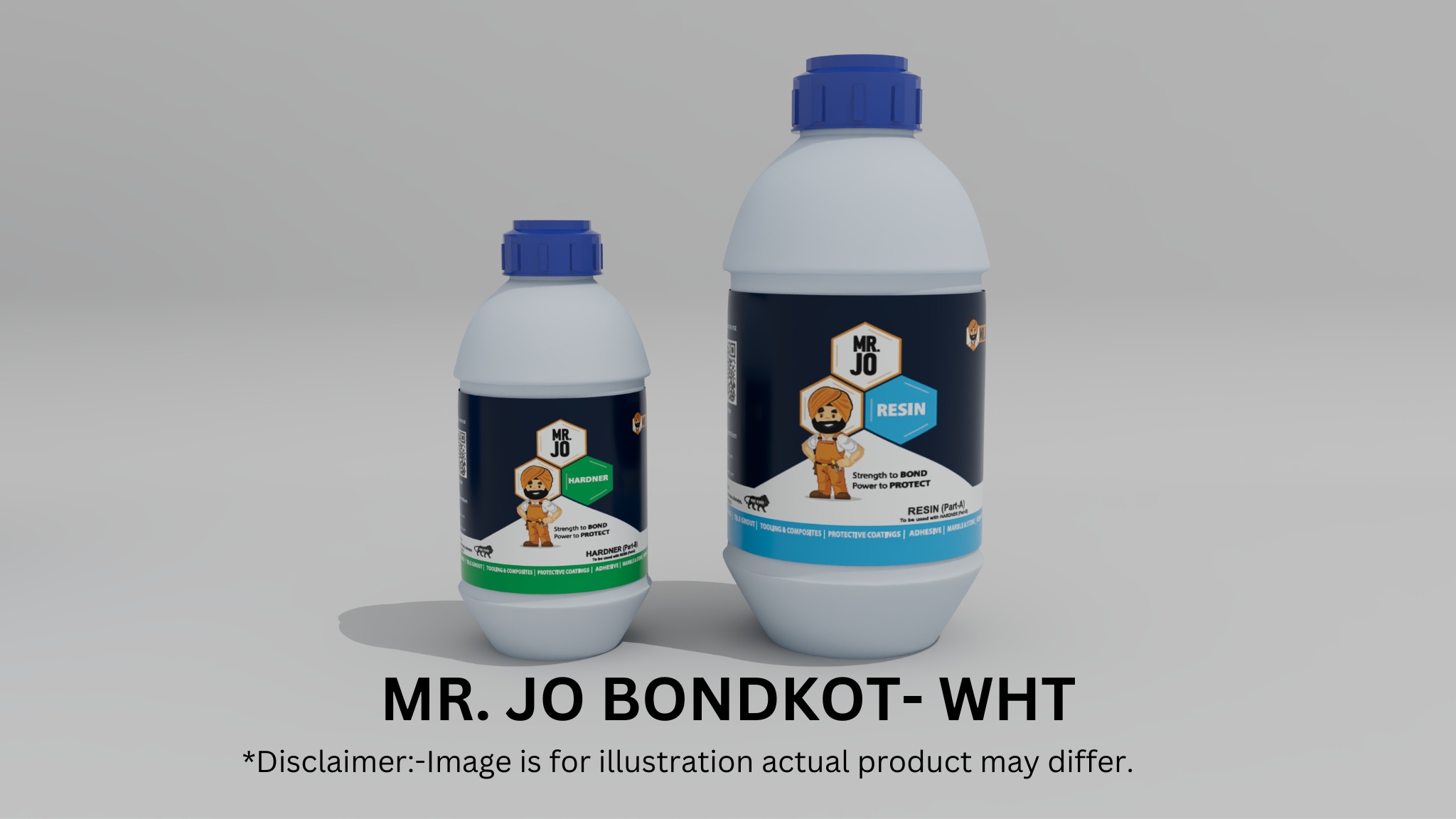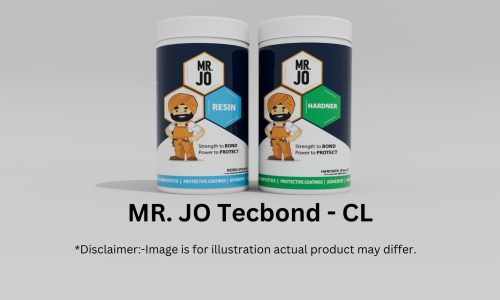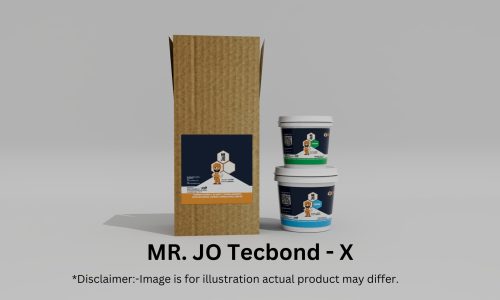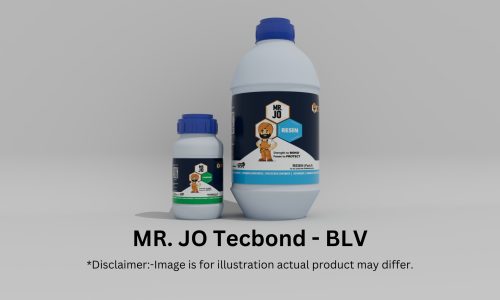MR. JO Tecbond – LVI
₹704.00 – ₹3,344.00 Inclusive of all taxes
Two component 10 PHR epoxy adhesive for brush bonding.
- Description
- Properties
- Applications
- How To Use
- Technical Data Sheet(TDS)
- FAQs
Description
Mr. JO Tecbond – LVI is a glue with two parts. First, you mix them in a 100:10 ratio. Then, you can brush it on smoothly and evenly. Also, it lasts long and sticks very well. Because it stays wet for a long time, you have enough time to work. After it dries, it resists water and stays strong. Therefore, people use it for sealing, insulating, and potting. Finally, it leaves a clear, clean finish for many projects.
- Color: Clear
- Pot life @25°C: 75-95 mins
- Mixing Ratio: 100:10 PBW
- Mixture consistency: Low Viscous liquid
- Optics: Transparent
- Brush bonding
- Sealing
- Insulating
- Potting
- The mixture should be applied on a clean, rough and dry surface. This should be achieved by suitable mechanical and chemical means such as sandblasting Wire brushing or chemical etching. Suitable degreasing agent should be used to remove any grease, or oil traces on the surface.
- Use Jpoxy Part-A & Part-B in ratio 100:10 pbw. Mix the two components in small batches thoroughly for at least 2minutes. Apply the mix directly or using proper spatula to the pretreated surfaces.
- The joint components should be assembled as soon as the adhesive has been applied.
- Allow the material to cure for at least 24 hours before putting to use.
A1. These adhesives are engineered for paintbrush manufacturing, specifically to:
- Bond and anchor synthetic or natural filaments (bristles) into ferrules
- Ensure firm hold without shrinkage or expansion
- Maintain durability during usage and cleaning of brushes
A2.
| Product | Key Features | Positioning |
|---|---|---|
| LVI | Premium-grade with excellent flow, optical clarity, and strong adhesion | For high-end brush lines |
| BLV | Slightly more economical; similar performance with lower clarity | Mid-range volume production |
| LVT | Budget-friendly, adequate strength and flow | Mass-market brush production |
A3. MR. JO Tecbond – LVI is ideal for high-end brushes, especially those with:
- Clear or transparent ferrules
- Precision quality standards
- Export specifications where long-term bond integrity and appearance are critical
A4.MR. JO Tecbond – BLV or LVT are suited for automated or semi-automated brush lines where:
- Faster pot life is beneficial
- Slightly lower viscosity is manageable
- Volume efficiency matters BLV balances cost and quality, while LVT is great for high-output, lower-cost production.
A5. Yes. Controlled post-curing at 40–60°C can:
- Speed up strength development
- Improve dimensional hold Avoid rapid or uneven heating that could lead to thermal stress or bristle distortion.
A6. Once fully cured, the bond is:
- Water-resistant (including during brush washing)
- Stable under normal paint usage For solvent-heavy applications (e.g., acetone, alcohol-based mediums), LVI performs better due to higher chemical resistance.
A7. A 3–5 mm fill depth is usually sufficient, but may vary based on:
- Brush size
- Fiber type
- Ferrule geometry Ensure uniform fill to avoid hollow zones or filament pullout.
A8. If overfilled, yes. To avoid this:
- Control dosage using dispensing jigs
- Use vertical positioning during setting
- Choose LVT or BLV for slightly higher hold in ferrule base
A9. Low viscosity allows the adhesive to:
- Flow around and between bristles easily
- Fill the base of the ferrule completely
- Prevent air gaps and ensure a strong mechanical hold
- Mixing Ratio (Resin:Hardener): 100:10 by weight
- Pot Life:
- LVI: ~45–60 mins
- BLV: ~40–50 mins
- LVT: ~35–45 mins Always mix only as much as needed, as exotherm can accelerate cure in large volumes.
A11. Yes, with proper surface cleaning and slight abrasion:
- Aluminum, steel, and brass ferrules: Excellent adhesion
- Plastic ferrules: Perform well depending on polymer type (testing recommended) Q12. Can these adhesives work with both natural and synthetic bristles?
A12. Yes. They are compatible with:
- Natural hair (hog, camel, goat, etc.)
- Synthetic fibers (nylon, polyester, PBT, PET) Ensure fibers are clean, dry, and trimmed before bonding.
A13. No. They are 100% solids and do not shrink, ensuring dimensional stability inside the ferrule.
Q14. What is the cure time and strength development? A14.- Initial set: 3–4 hours (depending on ambient conditions)
- Full cure: 24 hours
- Heat curing can accelerate strength development.
A15. Slight yellowing may occur, especially if cured in bulk or exposed to high temperatures. LVI has better resistance to yellowing compared to BLV or LVT.
Q16. Can I trim or clean the brush base after curing?A16. Yes. The cured epoxy is rigid and machinable, allowing trimming or edge cleanup as needed.
Q17. Can these products be tinted or colored to match brand identity?A17. Custom coloring may be possible for bulk orders (MOQ applies). However, adding pigments may slightly affect:
- Viscosity
- Pot life
- Cure clarity Always validate modified formulations in pilot batches.
A18. Yes, when used with:
- Basic PPE (gloves, goggles)
- Proper ventilation Avoid prolonged skin contact. Refer to the product's MSDS for detailed safety instructions.
A19. Depends on ferrule size and fill volume. As a rough guide:
- 1 kg mix can produce 500–700 standard paintbrush units
- For larger industrial brushes, yield may vary significantly
- Store in cool, dry, sealed containers
- Keep away from direct heat or sunlight
- Shelf life: 12 months if unopened and properly stored

